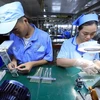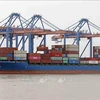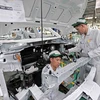HCM City (VNA) - Vietnam's plastics sector will maintain its strong growth rate of 14-16 percent in the next few years due to its young population and high consumption capacity, according to the Vietnam Plastics Association.
Falling oil prices will benefit the plastics manufacturing by lowering production costs but also boosting demand, Ho Duc Lam, Chairman of the association, said.
"The plastics manufacturing industry is one of the fastest-growing industries in Vietnam, sustaining an average annual growth of 16-18 percent between 2010 and 2015," he added.
"Vietnam's production output of plastics per capita increased sharply from 3.8 kg/per year in 1990 to the current 41kg/per year," Lam said at a workshop held on March 2 in HCM City.
In developed countries, the average per capita consumption is much higher. In Japan, it is 118kg/per year, in the US 155kg/per year and in the EU 146kg/per year.
Most of the production is concentrated on domestic items with packaging (37 percent), household appliances (29 percent), construction (18 percent) and technical products (15 percent).
Plastics in the technology industry such as pressure pipes and covers of TV have high added value but very few enterprises are engaged in this work, he added.
The biggest challenge for the domestic plastics industry is the import of raw materials, which accounts for 85-90 percent of raw materials.
The sector imports an average of 3.5 million tonnes of raw materials while domestically produced supplies of raw materials and chemicals are only 900,000 tonnes.
By 2020, domestic plastics producers would need five million tonnes of raw materials for manufacturing.
The plastics industry lacks technology and know-how, with many of the polymer manufacturers using out-of-date equipment imported from China.
The plastics industry needs to invest more than 2.5 billion USD in machinery every year.
Last year, plastics exports rose by 12.4 percent compared to the previous year, with export revenue totaling 2.4 billion USD.
The largest importers of Vietnam's plastics products were Japan (22 percent) and US (14.6 percent).
The sector has more than 2,200 enterprises, with private enterprises accounting for 99.8 percent and the remaining 2 percent belonging to State-owned enterprises.-VNA




















